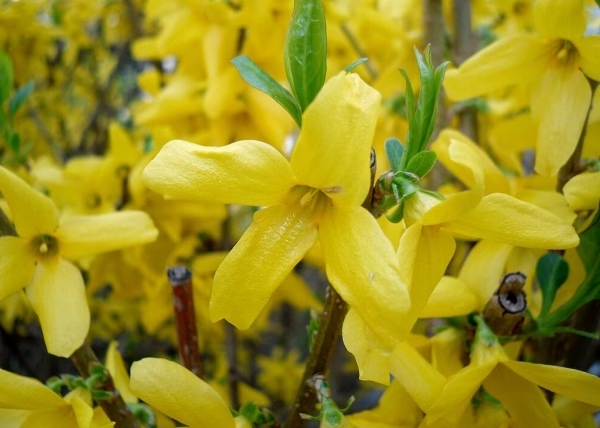
Forsythia
Botanical Name
:
Forsythia spp.
Plant Type
:
Deciduous flowering shrub
Seasons
:
Plant in early spring or fall; Blooms in early to mid-spring
Sun Level
:
Full sun to partial shade; blooms best with at least 6 hours of sunlight per day
Ideal Soil Temperature for Planting
:
55–70°F (12–21°C)
Soil Type
:
Well-drained, loamy, or sandy soil; can tolerate dry, poor soils
Hardiness Zones
:
3–9 (USDA)
Germination
:
Seeds germinate slowly (can take 6–12 weeks); propagation is typically done through cuttings or layering
P.H. Level
:
Neutral to slightly alkaline (6.5–7.5); adaptable to various pH levels
Water/Irrigation
:
Water newly planted shrubs once or twice a week; water as needed during hot, dry periods
Fertilization
:
Apply a balanced fertilizer with an NPK ratio of about 10-10-10 in early spring
Habit
:
Upright to arching growth habit; forms a fountain-like shape
Propagation
:
Softwood cuttings, layering, division
Final Plant Height
:
6–10 ft
Spread
:
8–12 ft
Flowers
:
Bright yellow, four-petaled blooms along bare stems before leaves emerge
Attracts
:
Bees, butterflies, and songbirds
Uses
:
Hedges, borders, mass plantings, erosion control
Companions
:
Daffodils, hyacinths, tulips, quince, and early-blooming magnolias
Pruning
:
Prune immediately after flowering; remove old wood to encourage new growth
Toxicity
:
Non-toxic to humans and pets; some species are used in traditional medicine
Pests
:
Generally pest-resistant; occasional issues with aphids or nematodes
Diseases
:
Minimal disease problems; possible anthracnose, leaf spot, yellow leaves, or stem cankers under unfavorable conditions
Fun Fact
:
Forsythia is named after William Forsyth (1737–1804), a Scottish botanist and one of the founders of the Royal Horticultural Society. Gardeners often use its early blooming as a natural signal to start pruning roses
Botanical Name
:
Forsythia spp.
Plant Type
:
Deciduous flowering shrub
Seasons
:
Plant in early spring or fall; Blooms in early to mid-spring
Sun Level
:
Full sun to partial shade; blooms best with at least 6 hours of sunlight per day
Ideal Soil Temperature for Planting
:
55–70°F (12–21°C)
Soil Type
:
Well-drained, loamy, or sandy soil; can tolerate dry, poor soils
Hardiness Zones
:
3–9 (USDA)
Germination
:
Seeds germinate slowly (can take 6–12 weeks); propagation is typically done through cuttings or layering
P.H. Level
:
Neutral to slightly alkaline (6.5–7.5); adaptable to various pH levels
Water/Irrigation
:
Water newly planted shrubs once or twice a week; water as needed during hot, dry periods
Fertilization
:
Apply a balanced fertilizer with an NPK ratio of about 10-10-10 in early spring
Habit
:
Upright to arching growth habit; forms a fountain-like shape
Propagation
:
Softwood cuttings, layering, division
Final Plant Height
:
6–10 ft
Spread
:
8–12 ft
Flowers
:
Bright yellow, four-petaled blooms along bare stems before leaves emerge
Attracts
:
Bees, butterflies, and songbirds
Uses
:
Hedges, borders, mass plantings, erosion control
Companions
:
Daffodils, hyacinths, tulips, quince, and early-blooming magnolias
Pruning
:
Prune immediately after flowering; remove old wood to encourage new growth
Toxicity
:
Non-toxic to humans and pets; some species are used in traditional medicine
Pests
:
Generally pest-resistant; occasional issues with aphids or nematodes
Diseases
:
Minimal disease problems; possible anthracnose, leaf spot, yellow leaves, or stem cankers under unfavorable conditions
Fun Fact
:
Forsythia is named after William Forsyth (1737–1804), a Scottish botanist and one of the founders of the Royal Horticultural Society. Gardeners often use its early blooming as a natural signal to start pruning roses
Written by Nondiah Khalayi – https://www.linkedin.com/in/nondiah-khalayi/

